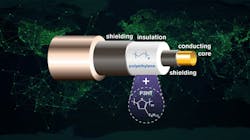Scientists from Chalmers University of Technology, Sweden have developed an insulation material that is about three times less conductive than the performance of typical high-voltage direct current cables.
Their research will have an impact on our electricity supply because of the efficiency gains in transporting electricity over long distances.
Currently, high voltage direct current cables, or HVDC cables, are the most efficient means of transporting electricity over long distances. HVDC systems operate on power electronics technology to convert AC and DC voltage. These systems are ideal for supporting existing systems or constructing new power networks. When insulated, HVDC cables can be buried underground or laid on the seabed, which opens up opportunities to connect networks over longer distances and tap into renewable energy sources such as wind and solar farms located on the outer reaches of cities.
“For us to handle the rapidly increasing global demand for electricity, efficient and safe HVDC cables are an essential component,” said Christian Müller, leader of the research and professor at Chalmers’ Department of Chemistry and Chemical Engineering. “The supply of renewable energy can fluctuate, so being able to transport electricity through long distance networks is a necessity for ensuring a steady and reliable distribution,” Müller said.
Optimizing performance over long distances is an important challenge because as little energy as possible should be lost during transportation. One way to reduce transmission loss, noted the researchers, is to increase the direct current voltage level. But this raises a problem: An increase in the transmission voltage adversely affects the insulation of an HVDC cable.
The way to address the resulting higher electric field stresses is to sufficiently reduce the electrical conductivity of the insulation material, explained Xiangdong Xu, research specialist at Chalmers’ Department of Electrical Engineering. Reducing the Conductivity of Insulation Material
The researchers developed a novel method for reducing electrical conductivity by introducing a new material into the cables. They added small amounts—5 parts per million—of the conjugated polymer known as poly(3-hexylthiophene) and succeeded at lowering the electrical conductivity by a factor of three. The additive, also known as P3HT, is a widely studied material, they said. Since very small amounts are required, it opens up new possibilities for manufacturers.
In previous research, nanoparticles of various metal oxides and other polyolefins were used to reduce conductivity, noted the researchers. The downside has been the need for significantly higher quantities.
“In materials science, we strive to use additives in as small quantities as possible, in order to increase the potential for them to be used in industry and for better recycling potential,” said Müller. “The fact that only a very small amount of this additive is required to achieve the effect is a big advantage.”
Future Scope
The researchers said that conjugated polymers, such as P3HT, have been used to design flexible and printed electronics. This is the first time P3HT has been used and tested as an additive to modify the properties of a commodity plastic, they said.
The discovery could lead to numerous new applications and directions for research. “Our hope is that this study can really open up a new field of research, inspiring other researchers to look into designing and optimizing plastics with advanced electrical properties for energy transport and storage applications,” said Müller.
About the Author

Rehana Begg
Editor-in-Chief, Machine Design
As Machine Design’s content lead, Rehana Begg is tasked with elevating the voice of the design and multi-disciplinary engineer in the face of digital transformation and engineering innovation. Begg has more than 24 years of editorial experience and has spent the past decade in the trenches of industrial manufacturing, focusing on new technologies, manufacturing innovation and business. Her B2B career has taken her from corporate boardrooms to plant floors and underground mining stopes, covering everything from automation & IIoT, robotics, mechanical design and additive manufacturing to plant operations, maintenance, reliability and continuous improvement. Begg holds an MBA, a Master of Journalism degree, and a BA (Hons.) in Political Science. She is committed to lifelong learning and feeds her passion for innovation in publishing, transparent science and clear communication by attending relevant conferences and seminars/workshops.
Follow Rehana Begg via the following social media handles:
X: @rehanabegg
LinkedIn: @rehanabegg and @MachineDesign

